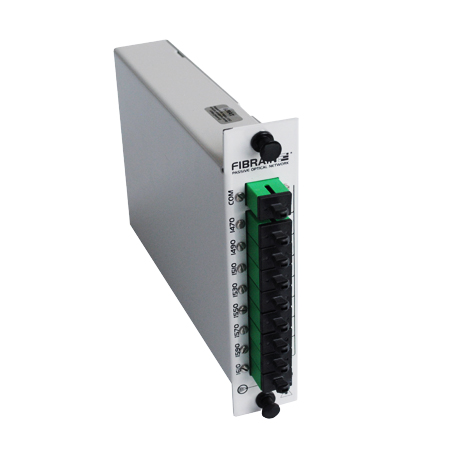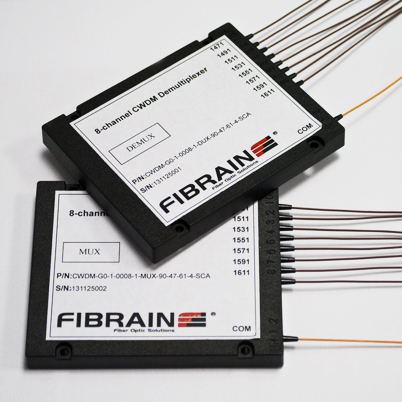Coarse Wavelength Division Multiplexing (CWDM) is often the final help for operators who lack fibers in a cable, and whose demand for bitrate increases. By using the CWDM technology, the capacity of one single mode optical fiber can be increased even 18 times, because so many CWDM channels have been standardized in the ITU-T G.694.2 recommendation. Currently, the prices of passive CWDM solutions decreased to a level that makes them available for almost every user. It is important to note that almost all CWDM solutions available on the market allow transmission only in single mode fibers. Fibrain as the first company in Poland has developed also a multimode CWDM system, which is presented in a separate whitepaper.
 Links that use CWDM transmission can be built in two basic technologies: as active solutions, using dedicated transport platforms, and passive solutions, in which there are no additional active components with transport layer. Naturally, active solutions that utilize a dedicated transport platform offer much more functionalities (such as signal monitoring, regeneration, and demarcation), however at the cost of a much higher price. In many situations, such additional functionalities are not critical, and operators decide in favor of significantly cheaper fully passive solutions. Fibrain of course offers also active CWDM solutions, which can be found in the “Active Devices” category.
Links that use CWDM transmission can be built in two basic technologies: as active solutions, using dedicated transport platforms, and passive solutions, in which there are no additional active components with transport layer. Naturally, active solutions that utilize a dedicated transport platform offer much more functionalities (such as signal monitoring, regeneration, and demarcation), however at the cost of a much higher price. In many situations, such additional functionalities are not critical, and operators decide in favor of significantly cheaper fully passive solutions. Fibrain of course offers also active CWDM solutions, which can be found in the “Active Devices” category.
CWDM passive solutions contain most importantly optical modules (transceivers), e.g. of SFP, XFP, Xenpak, X2 type, compliant with the CWDM standard, as well as passive optical filters. The advantages of a fully passive CWDM network, besides the low costs, are full independence from transmission protocols (e.g. 1GbE or 1G FC) an almost full independence from transmission speed (here power budget and chromatic dispersion can be the limits). Transceivers compliant with the CWDM standard are characterized mostly by a laser with wavelength and its stability compatible with the ITU-T G.694.2 recommendation. Using low quality lasers may lead to wavelength drift (with ageing or temperature) and power instabilities, which can cause problems with reaching stable transmission. Therefore, in the solutions we offer, we always recommend using both filters and modules (transceivers) produced by Fibrain. We offer CWDM transceivers in almost all standards ( including GBIC, SFP, SFP+, XFP, Xenpak, X2, etc.) with power budgets up to 41 dB.
As it was mentioned, there are 18 CWDM channels available, having filter central wavelengths from 1271 nm to 1611 nm with channel separation of 20 mm. Arbitrary combinations of these channels can be used in a CWDM link. Ensuring a stable and faultless CWDM network operation requires not only high quality lasers, but also passive optical filters. The most important qualitative parameters of CWDM filters and multiplexers are insertion loss, channel isolation, attenuation uniformity, and passband ripple. Optical filters can never have perfectly flat passband characteristics and a ripple is always present. The lower the ripple the better the filter quality. Unfortunately, most manufacturers deliberately do not inform about this fact, because they do not have the equipment to reliably measure the losses and isolation of filters. Most of them “measure” the insertion loss and isolation using CWDM SFP (or similar) modules as light sources. A SFP module compliant with CWDM standard randomly probes the filter profile in one point somewhere in the passband, but information obtained in this way do not tell anything about real worst case values of isolation and attenuation. Only measuring the whole spectral profile of a filter by using a wideband light source and an optical spectrum analyzer, or by a tunable laser, gives full information about the real values of attenuation and isolation. While purchasing CWDM multiplexers, one should always demand that test reports showing their whole spectral profile be included to ensure their quality.
.png) Passive CWDM systems offered by Fibrain are fully specialized and can include from 18 channels up to e.g. two channels: 1311 nm and 1611 nm, if the customer leases these two channels in a fiber from his transit operator.
Passive CWDM systems offered by Fibrain are fully specialized and can include from 18 channels up to e.g. two channels: 1311 nm and 1611 nm, if the customer leases these two channels in a fiber from his transit operator.
In CWDM networks, both point-to-point transmission and logical point-to-multipoint or optical broadcast can be realized. It is possible due to the available functionalities of CWDM filters, which can operate as:
-multiplexers and demultiplexers (in the beginning and at the end of a link), used for connecting or separating CWDM channels from an optical multiplex,
-add/drop filters, placed between the ending terminals, allowing separation of selected channels from an optical multiplex, without interrupting the transmission of other channels.

From the user’s point of view, the installation and handling of a passive CWDM system is very easy. In a typical case, the operator only plugs a line cable to one side of a classical patch panel, and the subscriber ports are connected to CWDM transceivers by patchcords. The transceivers can be placed in any network device (such as an Ethernet switch, IP router, or SDH cross-connect).
 Not only network functionalities, but also the design and housings can be fully specialized and adjusted to the customer’s needs. Both typical central 19’’ patch panels and filters for outdoor applications are available, such as prepared for splicing in closures or multiplexers in hermetic housing for installing e.g. on outdoor poles. Other typical standards of telecommunication housings (such as LGX, DIN) are of course also possible.
Not only network functionalities, but also the design and housings can be fully specialized and adjusted to the customer’s needs. Both typical central 19’’ patch panels and filters for outdoor applications are available, such as prepared for splicing in closures or multiplexers in hermetic housing for installing e.g. on outdoor poles. Other typical standards of telecommunication housings (such as LGX, DIN) are of course also possible.
Although the above examples of applications depicted only CWDM systems using a pair of fibers (2J), bidirectional CWDM transmission which utilizes one fiber (1J) is also possible (with certain limitations). All other additional functionalities, such as 1% power monitoring port, OTDR 1625/1650 nm monitoring port, 1310 nm grey port, Upgrade port, etc., are of course also available. Fibrain offers also solutions allowing various hybrid transmissions, such as CWDM/GPON, CWDM/DWDM, CWDM/CATV. To obtain more technical information, please contact your local sales representative or send us an email to info@fibrain.com.
- Optical Transmission Lexicon: CATV, CWDM, DWDM, FTTH
- PON Technology-Based FTTH Networks for GPON Transmission
- FTTH Networks in Rural Areas and Sparse Housing Conditions
- CATV in FTTH networks
- CWDM Overlay for GPON Networks
- Passive CWDM Solutions
- Passive DWDM solutions
- Multimode GPON Transmission System
- Multimode CWDM Transmission
- Selective Wavelength Filters for Applications in Next Generation Access Networks
